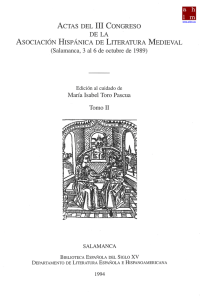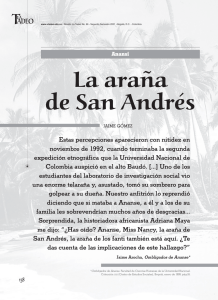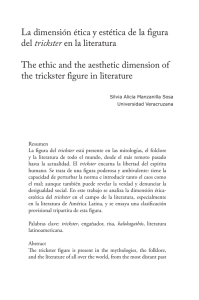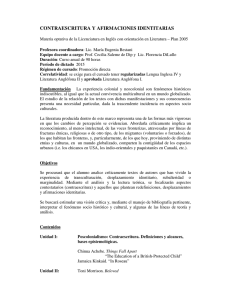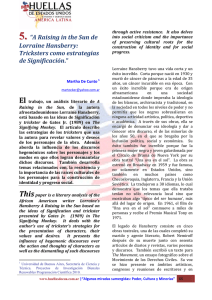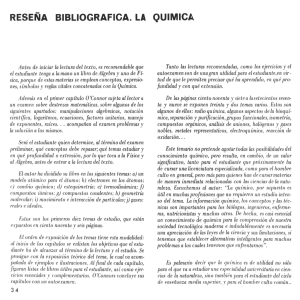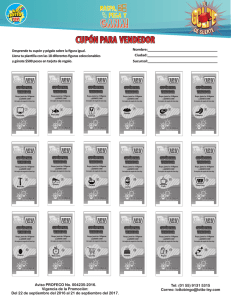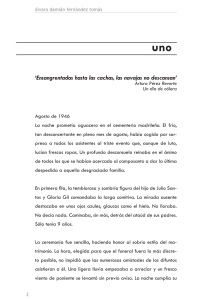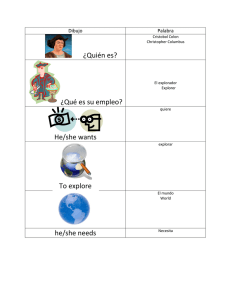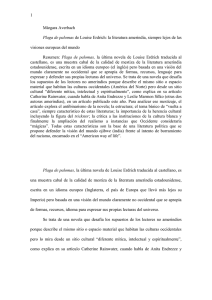maría antonia álvarez calleja
Anuncio
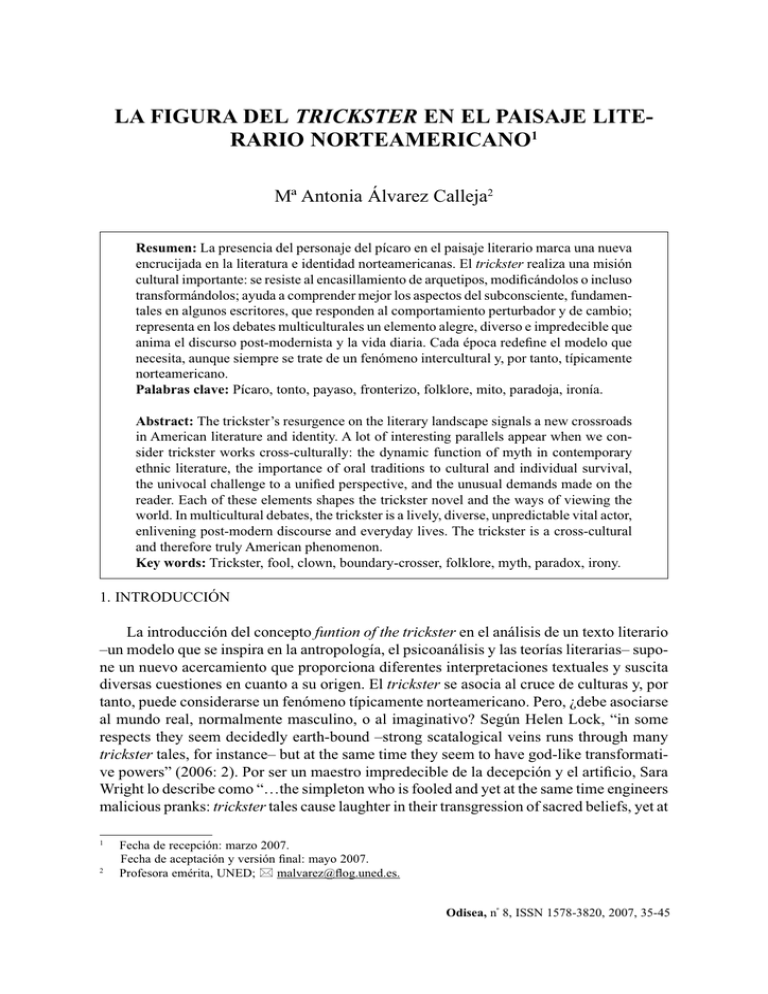
La figura del trickster en el paisaje literario... Mª Antonia Álvarez Calleja 35 LA FIGURA DEL TRICKSTER EN EL PAISAJE LITERARIO NORTEAMERICANO1 Mª Antonia Álvarez Calleja2 Resumen: La presencia del personaje del pícaro en el paisaje literario marca una nueva encrucijada en la literatura e identidad norteamericanas. El trickster realiza una misión cultural importante: se resiste al encasillamiento de arquetipos, modificándolos o incluso transformándolos; ayuda a comprender mejor los aspectos del subconsciente, fundamentales en algunos escritores, que responden al comportamiento perturbador y de cambio; representa en los debates multiculturales un elemento alegre, diverso e impredecible que anima el discurso post-modernista y la vida diaria. Cada época redefine el modelo que necesita, aunque siempre se trate de un fenómeno intercultural y, por tanto, típicamente norteamericano. Palabras clave: Pícaro, tonto, payaso, fronterizo, folklore, mito, paradoja, ironía. Abstract: The trickster’s resurgence on the literary landscape signals a new crossroads in American literature and identity. A lot of interesting parallels appear when we consider trickster works cross-culturally: the dynamic function of myth in contemporary ethnic literature, the importance of oral traditions to cultural and individual survival, the univocal challenge to a unified perspective, and the unusual demands made on the reader. Each of these elements shapes the trickster novel and the ways of viewing the world. In multicultural debates, the trickster is a lively, diverse, unpredictable vital actor, enlivening post-modern discourse and everyday lives. The trickster is a cross-cultural and therefore truly American phenomenon. Key words: Trickster, fool, clown, boundary-crosser, folklore, myth, paradox, irony. 1. INTRODUCCIÓN La introducción del concepto funtion of the trickster en el análisis de un texto literario –un modelo que se inspira en la antropología, el psicoanálisis y las teorías literarias– supone un nuevo acercamiento que proporciona diferentes interpretaciones textuales y suscita diversas cuestiones en cuanto a su origen. El trickster se asocia al cruce de culturas y, por tanto, puede considerarse un fenómeno típicamente norteamericano. Pero, ¿debe asociarse al mundo real, normalmente masculino, o al imaginativo? Según Helen Lock, “in some respects they seem decidedly earth-bound –strong scatalogical veins runs through many trickster tales, for instance– but at the same time they seem to have god-like transformative powers” (2006: 2). Por ser un maestro impredecible de la decepción y el artificio, Sara Wright lo describe como “…the simpleton who is fooled and yet at the same time engineers malicious pranks: trickster tales cause laughter in their transgression of sacred beliefs, yet at 1 2 Fecha de recepción: marzo 2007. Fecha de aceptación y versión final: mayo 2007. Profesora emérita, UNED; malvarez@flog.uned.es. Odisea, nº 8, ISSN 1578-3820, 2007, 35-45 36 Mª Antonia Álvarez Calleja La figura del trickster en el paisaje literario... the same time they focus attention on the nature of those beliefs highlighting the threshold between order and disorder, sacred and profane, centre and periphery” (2000: 3). La palabra trickster parece tener connotaciones negativas, aunque algunos sean tan sólo una fuente de entretenimiento o un símbolo cultural: los nativos americanos usan el coyote porque lo consideran un animal sagrado e inteligente comparado con el ciervo –por ejemplo, el coyote de Tomas King en Green Grass, Running Water– y muchos otros escritores consideran la figura del trickster central en sus obras, como un símbolo de continuidad y resistencia cultural, en una época de fragmentación que precisa del humor y la ironía. Para William Willeford, en The Fool and his Scepter: A Study in Clowns and their Audience, el trickster es “a special mythological form of the fool” (1969: 132), aunque después se pregunte si es simplemente una variante del bufón, o un ser imaginativo distinto. Lo que no hay duda es que se trata de una figura controvertida, cuya naturaleza parece estar dividida, ya que “the fool appears to share the trickster’s role as boundary-crosser, or as the enemy of boundaries” (ibid) y, al contrario del bufón, aspira a cambiar las reglas del mundo real y presiona los límites de lo no ortodoxo, a fin de transformar la realidad. El pícaro se diferencia del bufón en que para él no se trata de un juego, pues sus mañas cuestionan ideas fundamentales sobre la forma en que está organizado el mundo y ofrecen la posibilidad de transformarlas. Ni sorprenden sus antecedentes duales, tanto étnicos como culturales, ni al igual que el antihéroe puede simplemente arrogarse este término, ya que en su mundo las fronteras son continuamente cambiantes y las hipótesis controvertidas. 2. NATURALEZA HÍBRIDA Y CAMBIANTE DEL TRICKSTER FRONTERIZO DE BORDERLANDS En los estudios multiculturales, aparece el pícaro como un elemento bullicioso, diverso, impredecible y vital, que anima el discurso postmodernista y la vida cotidiana. Según Jeanne Rosier Smith en Writing Tricksters. Mythic Gambols in American Ethnic Literature, “All sorts of interesting parallels appear when we consider trickster works cross-culturally; the dynamic function of myth in contemporary ethnic literature, the importance of oral traditions to cultural and individual survival, the univocal challenge to a unified perspective, and the unusual demands make on the reader” (1997: 9). Cada uno de estos elementos da forma a la novela picaresca y pone en duda la forma en que los lectores ven el mundo. La presencia del trickster es paralela al desarrollo de la literatura étnica norteamericana, como ocurre con la literatura chicana, donde los borders y boundaries fluctúan y se difuminan gracias a la proliferación de este personaje, que acaba desbaratando las tradiciones establecidas. Es cambiante, viejo y perpetuamente nuevo. Como intérprete, contador de historias o elemento transformador, el trickster es un gran conocedor del cruce de fronteras, del intercambio, de la complejidad, la diversidad y la paradoja, cuya presencia es cada vez mayor en los estudios literarios actuales, que demandan la aparición de voces competitivas. Para Smith, el resurgimiento del “trickster” en la literatura multicultural contemporánea debe mucho de su espíritu al “trickerism” del cambio de siglo como resistencia política y expresión creativa, aunque “today’s publishing industry and reading public are radically different from those at the turn-of-the-century, and constructions on trickerism have changed” (1997: 10). Odisea, nº 8, ISSN 1578-3820, 2007, 35-45 Mª Antonia Álvarez Calleja La figura del trickster en el paisaje literario... 37 La literatura chicana, cada vez más floreciente, trata de poner de manifiesto lo restringido e inadecuado de los cánones tradicionales, y la aparición del pícaro en el paisaje literario señala una nueva encrucijada de la literatura e identidad norteamericanas: la obra de Sandra Cisneros claramente demanda una lectura marcada por esta figura, aunque quizás sea Gloria Anzaldúa quien lo relacione más explícitamente con su sentido del yo, ya que se llama a sí misma: “a cross-road inhabited by whirlwinds” (Anzaldúa y Moraga 1983: 205). La escritora se inspira en la imagen del trickster para describir el viaje vital de la mestiza, la mujer de herencia cultural mixta, explicando que la new mestiza se enfrenta a una posición parecida a este personaje “by developing a tolerance of tradition, a tolerance for ambiguity. She learns to juggle cultures. She has a plural personality, she operates in a pluralistic mode… Not only does she sustain contradictions, she turns the ambivalence into something else” (B 70). En su obra The Trickster of Liberty, Gerald Vizenor explora ese mundo de cruces y mezclas de sangre de los nativos norteamericanos y los de ascendencia europea, ejemplificado por el cross-blood trickster, que tanto afecta a la narración debido al diferente discurso que introduce: “the trickster is a comic nature in a language game, not a real person or ‘being’ in the ontological sense” (1988: x). El “trickster” cambia y transforma las fronteras, deshace y vuelve a trazar los límites tradicionales: “‘Terminal creeds’ have typically given rise to the kind of definitive ethnic markers that divide the world rigidly into ‘sides’, and demand to know which side you are on. The cross-blood trickster, however, is on both sides at once, and in any case questions the received definition of ‘sides’” (1988: 7). Además, este personaje parece personificar muchas de las características del postmodernismo, como la manipulación del lenguaje o la ambigüedad para eludir la verdad, pudiendo distinguirse su función según la época que lo crea: “the self-reflexivity is absent in the ancient ‘unconscious’ trickster. The contemporary trickster, by contrast, is largely self-aware, unlike his/ her archaic counterpart” (1988: 8). Puesto que la figura del trickster se asocia al cruce de culturas, se trata de un fenómeno típicamente americano, como ocurre en Borderlands, donde Gloria Anzaldúa trata de ilustrar los aspectos teóricos de las transformaciones que se producen por el cruce de fronteras: por ejemplo, su uso de material autobiográfico para describir las borderlands como la convergencia de gentes, lugares e ideas aparentemente diferentes. Según Ana Louise Keating, Anzaldúa comienza describiendo tan sólo su propia situación regional y luego va moviéndose hacia el exterior, ampliando esas borderlands geográficas entre Texas - Mexico y presentando la descripción convencional de borders como las fronteras entre “discrete locations to incorporate psychic, cultural, and sexual boundaries as well, Anzaldúa invents a metaphor that vividly illustrates threshold positioning. She does constructs flexible, nonrestrictive subjects positions for social actors” (1996: 12). Para Anzaldúa, las gentes que habitan las tierras fronterizas no se definen en términos monolíticos, sino que son razas mixtas complejas que no pueden ni ser reducidas a una sola esencia ni categorizadas de forma rígida, y esta forma híbrida de frontera sirve para ilustrar mejor los nuevos modelos teóricos. Así, al combinar autobiografía con narrativa histórica, poesía, fantasía y mito Anzaldúa transgrede las fronteras genéticas preestablecidas y desdibuja las formas convencionales del discurso. Reemplaza la noción humanística del yo unificado y estable de la autobiografía tradicional occidental por una subjetividad Odisea, nº 8, ISSN 1578-3820, 2007, 35-45 38 Mª Antonia Álvarez Calleja La figura del trickster en el paisaje literario... fluida y cambiante. En Borderland, Gloria Anzaldúa presenta un discurso radical: no sólo transforma sus propias diferencias en una fuente de poder personal y textual, sino que usa esa diferencia entre ella y sus lectores para alterar la visión del yo o del mundo, a fin de producir un impacto en sus lectores. Aprovechando el efecto performativo de la lengua, Anzaldúa inventa metáforas –como borderland, new mestiza– que la permiten construir identidades híbridas e ir más allá de los detalles específicos de su propia identidad cultural y sexual. Además, según Keating, la autora incorpora teorías feministas estadounidenses que “untie concepts of unitary selves to address and board readership” (1996: 14-15); usa sus experiencias como mestiza –especialmente las tácticas desarrolladas para negociar entre las tradiciones mejicana, india, española y angloamericana– para crear las formas de pensar diferenciales que se encuentran en la consciencia mestiza, creando textos híbridos, donde entremezcla cuestiones de tipo social –raza, clase, diferencias sexuales– con los elementos narrativos y poéticos de la historia. Gloria Anzaldúa ha estudiado de manera brillante la arbitrariedad de las fronteras y el sufrimiento que proporcionan, así como la dura realidad de la situación interna, y el reto y la satisfacción que produce la unión de tantas situaciones psíquicas múltiples. Ve la frontera entre Estados Unidos y Méjico como “‘una herida abierta’, where the Third World grates against the first and bleeds. And before a scab forms hemorrhages again, the blood of two worlds merging to form a third country culture” (1987: 1). Como afirma Shelley Fisher Fishkin en “Crossroads of Cultures: The Transnational Turn in American Studies”, Anzaldúa se niega a rechazar una parte de sí misma para acallar las voces contradictorias que se agolpan en su mente: “Me zumba la cabeza con lo contradictorio”, escribe en Borderlands. Pero el milagro consiste en que transforma ese zumbido en energía creativa: “En unos siglos, the future will belong to the mestiza. Because the future depends on the breaking down of paradigms; it depends on the straddling of two or more cultures” (1987: 2), añadiendo más adelante: “To survive the Borderlands, you must live sin fronteras/be a crossroads” (1987: 126). Y el énfasis de Anzaldúa en la ambivalencia sugiere la incapacidad de esa palabra, o de cualquier otra, para captar su propia identidad: ‘You say my name is ambivalence? Think of me as Shiva, a many-armed and legged body with one foot on brown soil, one on white, one in straight society, one in the gay world, the man’s world, the women’s… A sort of spider woman hanging by one think strand of web. Who me, confused? Ambivalent? Not so. Only your labels spit me.’ (Anzaldúa and Moraga 1983: 205) Ésta es la fuerza que caracteriza la identidad del trickster: su rechazo al efecto desmembrador de poner etiquetas y realizar clasificaciones demasiado cerradas. Al comienzo de nuestro siglo XXI, no hay duda de que los estudios norteamericanos están haciendo justicia cada vez con mayor fuerza a las transnational crossroads que son –y siempre han sido– los Estados Unidos. Cassie Premo Steele se pregunta: “¿why is it that scholars in the humanities and social sciences alike claim ‘Borderland’ as exemplary?” (2000: 3). Y la respuesta aparece en el capítulo 3 de su estudio, “‘Una herida abierta’: The Border as Wound in Gloria Anzaldúa’s Borderland/La Frontera”, donde explica que está en la figura del border que la escritora utiliza, una figura “that parallels Freud’s figure of Odisea, nº 8, ISSN 1578-3820, 2007, 35-45 Mª Antonia Álvarez Calleja La figura del trickster en el paisaje literario... 39 trauma as a wound” (2000: 42). Anzaldúa describe la tierra fronteriza entre Estados Unidos – Mexico como una herida, un lugar de trauma histórico que continúa afectando las experiencias actuales de individuos y comunidades: “As a person, I, as a people, we, Chicanos, blame ourselves, hate ourselves, terrorise ourselves. Most of it goes on unconsciously; we only know that there is some thing ‘wrong’ with us, something fundamentally ‘wrong’” (Anzaldúa 1987: 45). En la novela de Anzaldúa, el border funciona no sólo como un lugar fronterizo en el sentido literal, sino como una reconstrucción figurativa, y por eso el poema que inicia el primer capítulo dice: “mile-long open wound / dividing a ‘pueblo’, a culture, / running down the length of the body / staking fence rods in my flesh / splits me, splits me / me raja, me raja” (1987: 2). Para Cherríe Moraga, “…this image holds, speaks to something more profound that the intellectual knowledge of the loss of half our territory to the United States, with the signing of the Treaty of Guadalupe in 1848. It speaks of a collective wound we remember as a people and proffers the possibility of healing. This vision informs the whole book” (1993: 52). Con el cambio del inglés al español, Anzaldúa nos presenta el border como una herida, como una reproducción subversiva de las formas lingüísticas dominantes, volviendo a instar a sus compatriotas: “No se raje / Don’t give up, Chicanita” (Anzaldúa 1987: 2), aconsejando, así, a su nieta cómo hay que sobrevivir en las borderlands y superando el objetivo de sobrevivir a una historia traumática por otro más positivo y optimista: el de promover la supervivencia colectiva futura. Pero, para sobrevivir se necesitan la acción colectiva de su grupo étnico, a fin de conseguir superar la tradición del silencio que han venido soportando durante siglos: “I will no longer be made to feel ashamed of existing. I will have my voice: Indian, Spanish, white. I will have my serpent’s tongue –my woman’s voice, my sexual voice, my poet’s voice. I will overcome the tradition of silence” (1987: 59). 3. REMINISCENCIAS DEL FOLKLORE Y EL MITO EN EL TRICKSTER GROTESCO DE “A GOOD MAN IS HARD TO FIND” Gran parte de la ficción de Flannery O’Connor podría ilustrar los aspectos opuestos que van desde lo demoníaco a lo mesiánico, ya que en sus obras aparece el pícaro bajo un disfraz de tonto, bufón y profeta. Incluso para Ruthamn Knechel Johansen, “without the trickster to assist interpretation, Flannery O’Connor’s narratives, may even be blasphemous, but through it the reader readmits her evil and goodness, the fall and redemption, distortion and violence” (1994: 8). En “A Good Man is Hard to Find”, el desarrollo del argumento –que trata del accidente de coche que interrumpe el viaje familiar, terminando en viajes individuales al interior del bosque para matar a cada uno de los miembros de la familia– reúne todos los aspectos perturbadores y transformativos propios de este personaje. El relato de Flannery O’Connor tiene algunas características que subrayan lo que hay de íntimo y noble en la humanidad: The love shaping her stories is something personal, precisely defined, intensely alive; love confronts every horrifying situation as it arises anew in the physical assaults and the emotional battering that punctuate her stories. The impact of love comes from through Odisea, nº 8, ISSN 1578-3820, 2007, 35-45 40 Mª Antonia Álvarez Calleja La figura del trickster en el paisaje literario... the small fidelities –the tying of shoelaces, the extending of a hand– performed in service to the mystery of the Word. (Giannone 1999: 4) No obstante, la verdadera originalidad del cuento está en la confrontación que se produce entre los distintos personajes y el desarrollo de los hechos: desde el primer diálogo entre los miembros de la familia para preparar su viaje a Florida hasta que matan a la abuela, ninguno de ellos transmite mensajes que sirvan para unirlos ni para establecer comunicación; por el contrario, todos están solos, aislados: ‘Let’s go through Georgia fast so we won’t have to look at it much,’ John Wesley said. ‘If I were a little boy,’ said the grandmother, ‘I wouldn’t talk about my native state that way. Tennessee has the mountains and Georgia has the hills.’ ‘Tennessee is just a hillbilly dumping ground,’ John Wesley said, ‘and Georgia is a lousy state too.’ (O’Connor 1991: 910) La abuela no aprueba el viaje, y por ello trata de desbaratar los planes de la familia, recordando la noticia que aparece en el periódico sobre un preso peligroso que acaba de escaparse de su celda: ‘Now look here, Bailey,’ she said, ‘see heder, read this,’ and she stood with one hand on her thin hip and the other rattling the newspaper at his bald head. ‘Here this felow that calls himself the Misfit is aloose from the Federal Pen and headed toward Florida and you read here what it says he did to these people. Just read it. I wouldn’t take my children in any direction with a criminal like that aloose in it. I couldn’t answer to my conscience if I did.’ (909) En la escena cumbre de la historia, cuando la abuela se sienta en el suelo al lado de Misfit para charlar, los dos personajes cambian palabras que difieren de las normas sociales: “‘Do you ever pray?’ she asked. ‘Nome,’ he said. ‘I was a gospel singer for a while,’ the Misfit said. ‘Pray, pray,’ the grandmother began, ‘pray, pray...’” (G 916). Misfit no puede admitir que su ofensa se ajuste al castigo recibido y pronuncia expresiones muy duras, identificándose con Jesús: “‘I never was a bad boy that I remember of. Jesus threw everything off balance. It was the same case with Him as with me except He hadn’t committed any crime and they could prove I had committed one because they had the papers on me… I call myself the Misfit’” (916). Durante esta conversación, los otros dos reclusos asesinan al resto de la familia, uno tras otro, sin hacer ningún comentario, y los dos personajes principales presencian sin mostrar la menor emoción los horrores que tienen lugar en el bosque, produciéndose grotescas distorsiones de las virtudes cristianas como bondad, caridad, reconciliación. El giro irónico se produce cuando de pronto la abuela se dirige a Misfit para llamarle hijo: “She saw the man’s face twisted close to her own as if he were going to cry and she murmured, ‘Why you’re one of my babies. You are one of my own children!’ She reached out and touched him on the shoulder. The Misfit sprang back as if a snake had bitten him and shot her three times through the chest” (917). De este modo, la abuela reconoce una culpabilidad compartida con Misfit en su mundo demoníaco, a lo que él responde que la anciana Odisea, nº 8, ISSN 1578-3820, 2007, 35-45 Mª Antonia Álvarez Calleja La figura del trickster en el paisaje literario... 41 hubiera sido diferente si alguien la hubiera disparado varias veces durante su vida: “‘She was a talker, wasn’t she?’ ‘She would have been a good woman,’ the Misfit said, ‘if it had been somebody there to shoot her every minute of her life’” (917). Como afirma Johansen, en “A Good Man is Hard to Find” “the doubled characters –the Misfit with cynical doubts and the grandmother with sentimental faith– are pulled irresistibly together by the centripetal force of events, leading to the accident and to the central confrontation, discussing about goodness and suffering” (1994: 153). Hay un instante de conversión antes de que Misfit mate a la abuela: “‘Jesus was the only One that ever raised the dead,’ the Misfit said, and his voice had become almost a snarl. ‘I wish I had of been there,’ he said, hitting the ground with his fist. ‘It ain’t right I wasn’t there because if I had of been there I would of known and I wouldn’t be like I am now’” (O’Connor 1991: 917). Todo ello pone de manifiesto la utilidad del trickster para los propósitos artísticos y religiosos de O’Connor, ya que, según Johansen, “between the expressions of these figures and beneath the manifest levels of O’Connor’s narrative, we discover a latent level charged with residues of folklore and myth in which tricksters have traditionally operated, and thus the artist herself performs operations filled with paradox and irony akin to the tricksters” (1994: 153). 4. EL TRICKSTER ESTÉTICO DE TAR BABY EN LA DESCRIPCIÓN DEL PUNTO DE VISTA NARRATIVO DE MIJAIL BAJTÍN El hecho de que Toni Morrison centre su novela picaresca Tar Baby (1981) en un relato popular afro-americano demuestra la creciente relevancia de este personaje en el mundo contemporáneo y el interés que la escritora muestra por sus estrategias. La figura del trickster está mucho más presente en la ficción de Morrison de lo que pueda sugerir su reescritura de ese cuento popular, ya que procede de su pasión por la historia de su propia comunidad. Como afirma Smith: The trickster, whose fluidity and rule breaking define and maintain culture, embodies a central paradox in Morrison’s work: that of balancing the urge to maintain and foster cultural tradition and the equally powerful urge to rebel against its strictures. In her novels, the trickster –as character and as a part of novel form– helps to preserve, define, and defend community while constantly violating its confines. (1997: 111-12) Las técnicas que utiliza Morrison recuerdan la descripción del punto de vista narrativo de Mijail Bajtín. Comparando las estrategias que ha venido utilizando la ficción con las de la novela picaresca, Bajtín sugiere que estas técnicas han estado presentes en la novela desde sus comienzos: The novelist stands in need of some spiritual formal and generic mark that could serve to define the position from which she views life, as well as the position from which she makes that life public. And it is precisely here, that the mask of the clown and the fool (transformed in various ways) come to the aid of the novelist. These masks are not invented: they are rooted deep in the folk. (1981: 163) Odisea, nº 8, ISSN 1578-3820, 2007, 35-45 42 Mª Antonia Álvarez Calleja La figura del trickster en el paisaje literario... Y lo mismo ocurre con su descripción sobre el poder liberador que introduce este personaje en la literatura, muy semejante a la libertad lingüística de los significantes afroamericanos que Morrison usa en su novela Tar Baby: In the struggle against conventions, and against the inadequacy of all available life-slots to fit an authentic human being, these masks take on an extraordinary significance. They grant the right not to understand, the right to confuse, to tease, to hyperbolize life; the right to parody others while talking, the right to not be taken literally, not “to be oneself”;…the right to rip off masks, the right to rage at others… –and finally, the right to betray to the public a personal life, down to its most private and prurient little secrets. (1981: 163) El clown y el bufón de Bajtin son una versión del trickster, y no es sorprendente que en una novela picaresca como Tar Baby, las técnicas marcadas por este personaje definan la forma narrativa del texto. El narrador de Tar Baby es un espía y un reflector perpetuo de la vida que pasa y se transmite de un personaje a otro, ya que, como afirma Smith, “Son’s struggle against conventions, his refusal to be labelled, his skill at signifying, and his access to the house’s secrets all match Bajtin’s description and embody the novel’s tricksterlike narrative perspective” (1997: 146). Un autor puede mitigar el sentido de “alienating otherness” por medio de la creation de un narrador “hyper-ethnicized”, una especie de “trickster” sabio o bufón, “funkier-than-thou” (Giaimo 2003: 133), que reflexiona en torno a preocupaciones relevantes para todos los lectores, no simplemente para aquellos que son miembros de su grupo étnico. Pero, ¿qué ocurre cuando el autor crea un narrador que es a su vez miembro de su propio grupo étnico y también tipifica las formas más extremas y visibles de estereotipos de ese grupo? Esto tiene implicaciones en un estudio más profundo de las teorías bajtiniana y de la recepción, aplicadas al narrador humorístico étnico. Bajtín afirma que una de las formas básicas de incorporar y organizar la heteroglosia de la novela es “a comic playing with languages” (1997: 323). Para Giaimo, la heteroglosia de Bajtín representa simultáneamente dos intenciones diferentes: “the direct intention of the character who is speaking and the refracted intention of the author”, añadiendo que “the internal dialogism of authentic prose discourse… cannot fundamentally be dramatized or dramatically resolved” (2003: 324). Otro aspecto importante es la relación entre novela picaresca y género, una cuestión controvertida en la crítica reciente. El trickster premodernista se consideraba principalmente masculino, aunque con habilidad para cambiar de género. Pero, ¿es una coincidencia que muchas de las escritoras norteamericanas contemporáneas de mayor éxito e importancia incluyan este personaje en sus novelas? Smith ha encontrado muchas figuras de tricksters femeninos en Morrison, desde Pilate a Catwomen (1997: 20), pero “the most successful and visionary trickster of Toni Morrison’s novels is Morrison herself” (1997: 142). Y en su ensayo “Literature and Ethnicity in the Cultural Borderlands”, Mª Antonia Oliver-Rotger analiza los mecanismos técnicos postmodernistas de la novela de Morrison, tales como la distinción entre verdad y ficción o la multiplicidad de discursos que hacen lo real misterioso, si no inaccesible: “postmodernist narrative techniques serve a larger purpose of bringing into view the epistemological domination that goes hand in hand with slavery”, añadiendo que “critical analysis is at its best in those essays unraveling imbricated textual Odisea, nº 8, ISSN 1578-3820, 2007, 35-45 Mª Antonia Álvarez Calleja La figura del trickster en el paisaje literario... 43 and ideological transgressions for the exposure and/or contestation of colonial patterns in intercultural relations” (2004: 311). En Tar Baby Toni Morrison se plantea diversas cuestiones a nivel narrativo, mientras elige las estrategias necesarias para construir su novela picaresca. Según Smith, la autora crea nuevas formas artísticas tratando de que el lector “come up to the lesson” y “enter into the act of communication”; pero, el trickster estético de Morrison quizá pueda captarse mejor en su propia descripción: “unpolished, seditious, confrontational, manipulative, inventive, disruptive” (1994: 142-3), ya que influye en los aspectos lingüísticos para desbaratar, perturbar y crear su lenguaje claramente afro-americano, donde abundan la paradoja, la contradicción y la perspectiva múltiple que permiten al narrador una libertad similar a la de este personaje. “The language”, explica en su ensayo “Memory, Creation and Writing”, “if it is to permit criticism of both rebellion and tradition” (1984: 389), debe ser al mismo tiempo indicador y encubridor, y la tensión entre estas dos clases de discurso supone su liberación y su poder. En resumen, la figura del trickster realiza una misión cultural básica en la literatura, ya que ayuda a comprender mejor los aspectos del subconsciente, fundamentales en algunos escritores, que responden al comportamiento perturbador y de cambio que caracteriza a este personaje. Cada época redefine el modelo que necesita, resistiéndose al encasillamiento de arquetipos, prefiriendo por el contrario modificarlos y transformarlos cuando una nueva época ofrece la oportunidad de hacerlo. Las estrategias que caracterizan el lenguaje del pícaro aparecen donde quiera que haya una tradición folclórica literaria, y suelen encontrarse en el protagonista de cualquier historia que implique cambios de género. El personaje del trickster es una forma o mezcla maliciosa de lo sagrado y lo profano, que realiza milagros y viola tabús; se burla del orden, permaneciendo en la encrucijada de la paradoja y la ambigüedad; disfruta con la confusión de fronteras, y se le asocia al cruce de culturas, por lo que puede considerarse un fenómeno típicamente norteamericano, que supone una nueva encrucijada en su literatura e identidad. REFERENCIAS BIBLIOGRÁFICAS ANZALDÚA, G. 1987. Borderlands/La Frontera: The New Mestiza. San Francisco: Aunt Lute Books. ANZALDÚA, G. y Ch. L. MORAGA. 1983. The Bridge Called my Back: Writing by Radical Women of Color. New York: Kitchen Table, Women of Color Press. ASSALS, F. 1982. Flannery O’Connor: The Imagination of Extremity. Athens, GA: University of Georgia Press. BAKHTIN, M. M. 1981. The Dialogic Imagination: Four Essays. Ed. Michael HOLQUIST. Trans. Caryl Emerson and Michael Holquist. Austin: University of Texas Press. BELLAMY, M. O. 1979. “Everything off Balance: Protestant Election in Flannery O’Connor’s ‘A Good Man is Hard to Find?’”. The Flannery O’Connor Bulletin 8: 110-117. Odisea, nº 8, ISSN 1578-3820, 2007, 35-45 44 Mª Antonia Álvarez Calleja La figura del trickster en el paisaje literario... BLEIKASTEN, A. 1985. “The Heresy of Flannery O’Connor”, Critical Essays on Flannery O’Connor. Boston: G.K. Hall and Co. 151-162. FISHKIN, S. F. 2005. “Crossroads of Cultures: The Transnational Turn in American Studies”. American Quarterly 57, 1: 17-58. GENTRY, M. B. 1986. Flannery O’Connor’s Religion of the Grotesque. Jackson: University Press of Mississippi. GIAIMO, P. 2003. “Ethnic Outsiders: The Hyper-Ethnicized Narrator”. Laughton Higher y Fred L. Gardaphe. MELUS 28, Fall: 22-37. GIANNONE, R. 1999. Flannery O’Connor and the Mystery of Love. New York: Fordham University Press. HUGHES, L. 1999. The Best of Simple. New York: Hill and Wang. JOHANSEN, R. K. 1994. The Narrative Secret of Flannery O’Connor. Tuscaloosa and London: The University of Alabama Press. KEATING, A. L. 1996. Women Reading – Women Writing. Self-invention in Paula Gunn Allen, Gloria Anzaldúa and Audre Lorde. Philadelphia: Temple University Press. LOCK, H. 2006. “Transformations of the Trickster”. http:// southerncrossreview.org/18/ trickster.htm (25 August 2006). MORAGA, Ch. L. 1993. The Sexuality of Latinas. Berkeley: Third Woman Press. MORRISON, T. 1981. Tar Baby. New York: Blume. —————. 1984. “Memory, Creation and Writing”. Thought: A Review of Culture and Idea 59, 235: 385-390. —————. 1994. “Unspeakable Things Unspoken: The Afro-American Presence in American Literature”. Within the Circle. An Anthology of African-American Literary Criticism from the Harlem Renaissance to the Present. Ed. Angelyn MITCHELL. Durham, N.C.: Duke University Press. 368-398. O’CONNOR, F. 1970. Mystery of Manners: Occasional Prose. Eds. Sally and Robert FITZGERALD. New York: Farrar, Straus, Giroux. —————. 1991. “A Good Man is Hard to Find”. The Complete Stories. New York: Farrar, Straus, Giroux. OLIVER-ROTGER, M. A. 2004. “Literature and Ethnicity in the Cultural Borderlands”. MELUS 29, 2: 311–15. SMITH, J. R. 1997. Writing Tricksters. Mythic Gambols in American Ethnic Literature. Berkeley/Los Angeles/London: University of California Press. STEELE, C. P. 2000. The Heal from Memory. Sexton, Lorde, Anzaldúa, and the Poetry of Witness. New York: Palgrave. STEPHENS, M. 1972. The Question of Flannery O’Connor. Baton Rouge: Louisiana State University Press. Odisea, nº 8, ISSN 1578-3820, 2007, 35-45 Mª Antonia Álvarez Calleja La figura del trickster en el paisaje literario... 45 VIZENOR, G. 1988. The Trickster of Liberty. Minneapolis: University of Minneapolis Press. WILLEFORD, W. 1969. The Fool and his Scepter: A Study in Clowns and their Audience. Evanston, Il.: North Western University Press. WRIGHT, S. 2000. The Trickster Function in the Theatre of Garcia Lorca. London: Tamesis. Odisea, nº 8, ISSN 1578-3820, 2007, 35-45
